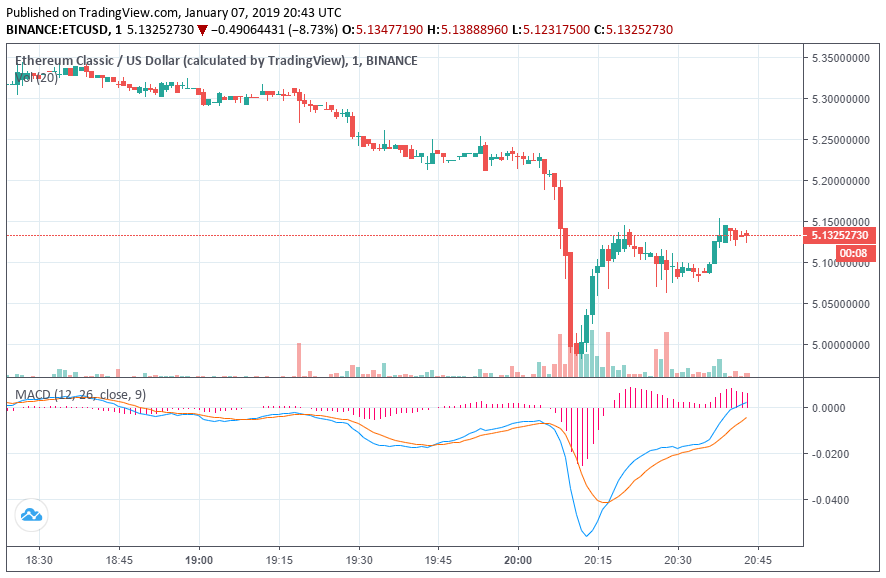Contradicting reports from the Ethereum Classic camp, cryptocurrency exchange giant Coinbase announced this afternoon that the apparent ETC blockchain reorganization attack had been accompanied by around half a million dollars in double spends.
Coinbase Detects Double Spends on Ethereum Classic Network
According to Coinbase, the firm first identified the deep chain reorganization on Jan. 5, at which point it halted on-chain ETC payments to protect customers — and the crypto exchange itself — from falling prey to a double spend attack.
On 1/5/2019, Coinbase detected a deep chain reorganization of the Ethereum Classic blockchain that included a double spend. In order to protect customer funds, we immediately paused movements of these funds on the ETC blockchain. Read more here: https://t.co/vCx89dz44m
— Coinbase (@coinbase) January 7, 2019
From the post:
On 1/5/2019, Coinbase detected a deep chain reorganization of the Ethereum Classic blockchain that included a double spend. In order to protect customer funds, we immediately paused movements of these funds on the ETC blockchain.
Notably, this was not a one-time event. Indeed, the attacks are apparently ongoing, but as of the time of writing at 3:15 pm ET, Coinbase said that it had identified at least nine reorganizations containing double spends. Altogether, these double spends amounted to 88,500 ETC or about $460,000 at current prices.
The firm wrote:
We observed repeated deep reorganizations of the Ethereum Classic blockchain, most of which contained double spends. The total value of the double spends that we have observed thus far is 88,500 ETC (~$460,000).
Background on Double Spend Attacks
Simply put, an attacker appears to have secured a majority of the Ethereum Classic hashrate, enabling them to “reorganize” the public ETC blockchain by creating a revised ledger and then publishing it to the rest of the network. As the saying goes, “the longest chain wins.” Executing a chain reorganization empowered the attacker to “reverse” certain transactions that had previously been confirmed to the network as valid transactions, effectively letting them spend the same coins twice.
Typically, these double spend attacks are directed at cryptocurrency exchanges. The attackers deposit funds to an exchange, convert them into another currency, and then withdraw them. At this point, the attacker reorganizes the blockchain’s recent history, sending the funds that they had previously sent to the exchange to a wallet in their control.
Exchanges generally respond to double spend attacks by dramatically increasing the number of confirmations required before they will credit a customer’s deposit, forcing the attacker to work much harder and take on more economic risk to continue to reorganize the blockchain and execute double spends.

These attacks would be incredibly difficult — perhaps virtually impossible — to mount against heavily-mined cryptocurrency networks like Bitcoin and Ethereum, but a number of small-cap cryptocurrencies fell prey to them in 2018, including Bitcoin Gold, ZenCash (now Horizen), Litecoin Cash, Vertcoin, and Verge (twice).
At present, Ethereum Classic ranks as the 18th-largest cryptocurrency with a market cap of more than half a billion dollars, highlighting the risks that these attacks present to even those cryptocurrencies generally listed in the market’s upper echelon.
Coinbase: We’re Not Affected by ETC Double Spends
Coinbase stressed that while it had identified the double spends, it had not been the target of these attacks and that all customer funds remained secure. At present, it is unclear who the attackers targeted.
CCN previously reported that the Ethereum Classic might have been the target of a successful 51 percent attack, though the project’s official Twitter account attributed the blockchain reorganization to a crypto mining manufacturer testing a new batch of ETC mining rigs and claimed that no double spends had been identified.
Ethereum Classic responded to the Coinbase announcement in a tweet, stating that the investigation is an “ongoing process” and that the crypto exchange had not shared its findings with ETC personnel prior to going public.
Regarding @coinbase account of recent events: they allegedly detected double spends but unfortunately did not connect with ETC personnel regarding the attack.
This is still very much an ongoing process. https://t.co/in1OGdV8T9— Ethereum Classic (@eth_classic) January 7, 2019
Developing…Check back for updates.
Featured Image from Shutterstock








